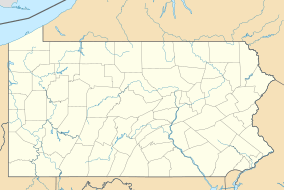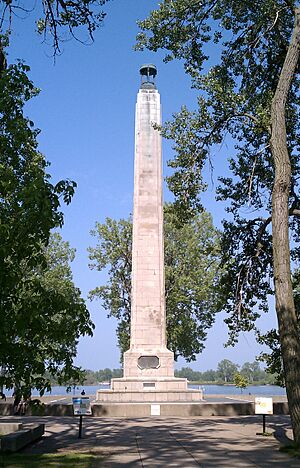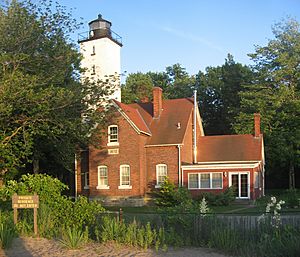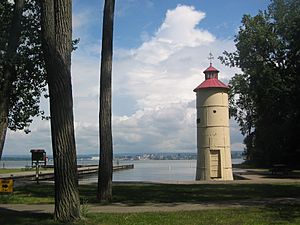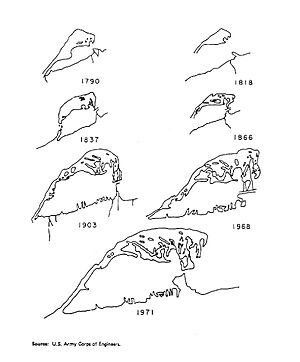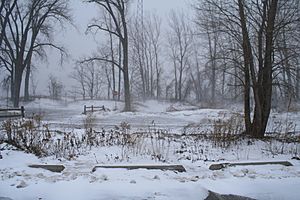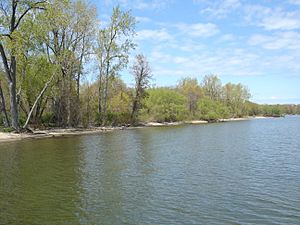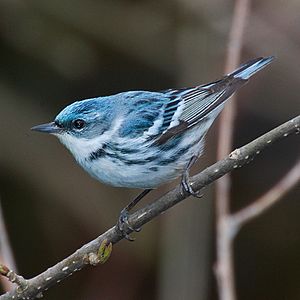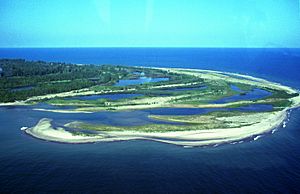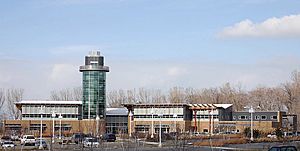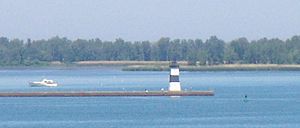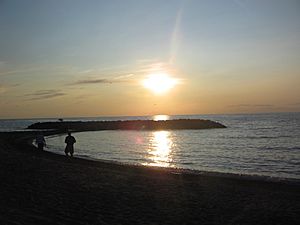Presque Isle State Park facts for kids
Quick facts for kids Presque Isle State Park |
|
|---|---|
|
IUCN Category IV (Habitat/Species Management Area)
|
|
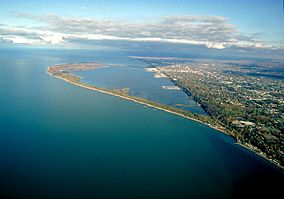
Aerial view of Presque Isle toward the east-northeast
|
|
| Location | Millcreek, Erie, Pennsylvania, United States |
| Area | 3,112.1 acres (12.594 km2) |
| Elevation | 576 ft (176 m) |
| Established | May 1921 |
| Named for | presqu'île, French for "peninsula" |
| Visitors | Over 4,000,000 annually |
| Governing body | Pennsylvania Department of Conservation and Natural Resources |
| Website | Presque Isle State Park |
| Designated: | 1967 |
Presque Isle State Park is a large park in Pennsylvania. It covers about 3,112 acres (1,259 hectares). The park is on a sandy strip of land that curves into Lake Erie. This land is called a peninsula. It is about 4 miles (6 km) west of the city of Erie.
The peninsula curves northeast, creating a calm area called Presque Isle Bay. The park has 13 miles (21 km) of roads and 21 miles (34 km) of trails. There are 13 beaches for swimming and a marina for boats. Many people enjoy swimming, boating, hiking, biking, and birdwatching here.
The history of Presque Isle goes back to the Erielhonan Native American tribe. Later, French, British, and American forts were built here. It was also a base for Commodore Oliver Hazard Perry's fleet during the War of 1812. As shipping grew on Lake Erie, lighthouses and a United States Coast Guard station were built.
In 1921, Presque Isle became a state park. Today, over 4 million people visit each year. This makes it the most visited state park in Pennsylvania.
The Presque Isle peninsula was formed by glaciers long ago. Waves and wind are always changing its shape. This creates seven different natural areas within the park. It is a great example of how nature changes over time. Since 1967, it has been a National Natural Landmark. It is also known as one of the best places in the United States for birdwatching. The Tom Ridge Environmental Center at the park's entrance helps visitors learn about its nature.
In 2024, Presque Isle State Park was in the path of a total solar eclipse. Visitors saw 3 minutes and 45 seconds of total darkness.
Contents
History of Presque Isle
Early People and Legends
Presque Isle was formed about 11,000 years ago. This was at the end of the last ice age. The first known people living near Lake Erie were the Erielhonan tribe. They were Native Americans who spoke an Iroquoian language. Their name meant "Cat" or "Raccoon" people. The name "Erie" comes from their tribe.
An Erielhonan legend says the Great Spirit led them to Presque Isle. They found lots of animals to hunt, clean water, and cool breezes. Another legend tells how their god protected them from a storm. The god laid his arm into the lake, creating the peninsula. This arm stayed there to protect future generations.
The Erielhonan tribe likely lived and farmed on the peninsula. They fought wars with the Iroquois. In 1654, their main village was destroyed. By 1656, the Erielhonan people were gone. Some survivors joined the Iroquois.
Forts and Battles
The French first named the peninsula in the 1720s. presque-isle means "almost an island" in French. In 1753, they built Fort Presque Isle where Erie is today. They also built two small military camps on the peninsula. During the French and Indian War, the French left their camps and burned their fort in 1759.
The British built a new fort that year. But Native American forces took it on June 19, 1763. This happened during Pontiac's Rebellion.
After the American Revolutionary War, Presque Isle became American land. In 1784, the Iroquois sold their rights to the land. Pennsylvania bought the land in 1792. In 1795, General Anthony Wayne built a new American "Fort Presque Isle". The town of "Presqu' Ile" was started nearby. It was later renamed Erie.
During the War of 1812, Presque Isle was important. Oliver Hazard Perry used the bay to build his fleet of ships. This protected his men from attacks.
The "Little Bay" near the peninsula's tip was later called "Misery Bay". This was because of the hard times during the winter of 1813–1814. Many men got sick and were kept away from others. Many who were sick died and were buried near what is now called Graveyard Pond.
After the Battle of Lake Erie in 1813, Perry's ship, the US Brig Lawrence, was sunk in Misery Bay. It was raised in 1875 but later burned. The US Brig Niagara was also sunk for preservation. Parts of it were used to build the Niagara we see today in Erie.
Lighthouses and Coast Guard
Presque Isle Bay is a natural harbor for Erie. As shipping grew on Lake Erie, aids for ships were built. Today, there are two main lighthouses in the park. The Erie Harbor North Pier Light started as a wooden tower in 1830. In 1858, a stronger steel structure replaced it. This light is still at the eastern end of the park.
The Presque Isle Light was built in 1872 on the north side of Presque Isle. It was first lit on July 12, 1873. This lighthouse is 74 feet (23 meters) tall. It has a red brick house where the lighthouse keeper lived. Today, the United States Coast Guard takes care of it. It flashes a white light to warn ships. You can visit the lighthouse on weekends from Memorial Day to Labor Day.
A smaller lighthouse was built in 1906. It is on the Presque Isle Bay side of the peninsula. Today, it stands near the ferry landing for the Presque Isle Water Taxi.
In 1876, a United States Life-Saving Service station opened at Presque Isle. This service rescued people from shipwrecks. In 1915, it became part of the United States Coast Guard. The station is still in use today.
The Park Today
In 1908, Erie began building a waterworks on Presque Isle. This provided fresh water for the city. Water from Lake Erie was pumped into basins. Dirt settled out, and the water was treated. This system worked until 1949. The old pumphouse is now a concession stand. You can rent bicycles and quadracycles there.
Presque Isle's beaches were already popular. In May 1921, the state made it the "Pennsylvania State Park at Erie". It quickly became the most popular state park in Pennsylvania. It was one of the first state parks built near a city.
The first paved road in the park was built in 1924. Today, 13 miles (21 km) of roads run through the park. Pennsylvania Route 832 is the main road into the park. The Perry Monument was built in 1926 near Misery Bay.
By 1937, the park was called "Presque Isle State Park". It had 1.4 million visitors that year. In the 1950s, the peninsula was made larger. Sand was dug from inside the peninsula to create new roads and parking. This digging also created the current marina. New bath houses were built in 1957. That same year, Gull Point was named a nature preserve.
In 1967, Presque Isle was named a National Natural Landmark. From 1989 to 1992, many breakwaters were built. These help control erosion along the shore. In 1997, the park was named an Important Bird Area (IBA). Gull Point was also named a "State Park Natural Area" for rare birds.
The Tom Ridge Environmental Center opened in 2006. It is at the park's entrance. Presque Isle is on the list of "25 Must-See Pennsylvania State Parks". This is because it has Pennsylvania's only surf beach. It is also a National Natural Landmark with amazing nature and history.
In 2008, parts of the movie The Road were filmed at Beach 10. In 2010, a weak tornado touched down in the park. It caused some damage and closed the park for a day. In 2012, Hurricane Sandy brought high waves. Luckily, the park only had minor flooding and some downed trees.
How Presque Isle Formed
Presque Isle is a sandy strip of land that curves. It formed during the last ice age. A huge ice sheet moved into the area of Lake Erie. When it melted, it left behind clay, sand, and gravel. This material formed the peninsula. Waves and wind are always moving this sand. This makes the peninsula slowly shift to the northeast.
The French name presqu'île means "peninsula" or "almost an island". Presque Isle has been an island a few times since 1819. The longest time it was an island was from 1832 to 1864. To stop erosion, concrete seawalls and groins were built in the 1950s. In 1992, 58 breakwaters were built. These help trap sand and slow its movement. Even with these projects, new sand must be brought in every year to keep the beaches healthy.
Presque Isle protects the natural Presque Isle Bay. This bay creates a deep harbor for the city of Erie. Many pleasure craft and cargo ships use the bay. Erie became an international port after the Saint Lawrence Seaway opened in 1959.
The park's climate is similar to Erie's. Erie is in a "snow belt". This means winters are cold with lots of lake-effect snow. But there are also mild periods when snow melts. Summers are not too hot because of the lake. Ice dunes often form along the beaches in winter. These dunes are made of snow and frozen water spray. They can be over 6 feet (1.8 meters) tall. They protect the beaches from winter storms.
Amazing Nature and Wildlife
Presque Isle has many unique habitats. It has more rare and endangered species than any other similar-sized area in Pennsylvania. The park has seven different natural areas. Each area has different plants and animals. These areas are: Lake Erie; the beaches and shoreline; sandy plains and ponds; sand dunes and ridges; marshes and old ponds; thickets and young forests; and old, mature forests.
Lake Erie is the first zone. It has 80 kinds of fish and at least six kinds of crustaceans. The other zones show how nature changes over time. This is called ecological succession. The shoreline is the second zone. Waves create it, and plants help hold the sand in place.
The sandy plains and ponds are the third zone. Ponds form when lake water gets trapped. Wind-blown sand can fill them, or they can wash away. These ponds are home to many plants and animals. For example, the park has 89 kinds of dragonflies and damselflies. It also has 35 different butterflies and 84 kinds of spiders.
Sand dunes and ridges are the fourth zone. Wind and waves carry beach sand. Plants trap it, forming dunes. Grasses help stabilize the dunes. Then other plants grow. This creates homes for amphibians, birds, mammals, and reptiles. Old dunes become ridges that protect ponds. These are often left over from older shorelines.
The fifth zone is old ponds and marshes. Ponds protected by dunes are more stable. They support more plant and animal life. As they fill with plants, they become marshes. These areas have many different kinds of living things. Nearly 400 types of land animals live on Presque Isle. This includes 318 different birds, 48 kinds of mammals, 13 kinds of amphibians, and 19 kinds of reptiles.
The sixth and seventh zones have shrubs and trees. Presque Isle State Park has 633 kinds of plants. The sixth zone is thicket and young forest. Shrubs grow on dying marshes. Then small trees grow. The trees shade out the shrubs, forming a young forest. The seventh zone is a mature forest. Here, large trees form a canopy. This natural process takes 500 to 600 years. But at Presque Isle, you can see all these zones in just 5 miles (8 km).
The Pennsylvania Audubon Society calls the park an Important Bird Area (IBA) #1. It is one of the best places for birdwatching in Pennsylvania. The park's different habitats are perfect for over 320 kinds of birds. Forty-five of these birds are rare or threatened. These include the piping plover and cerulean warbler. Many waterfowl and wading birds live here all year. Four kinds of gulls and three kinds of terns can be seen at Gull Point in summer.
Gull Point: A Bird Paradise
People have always affected Presque Isle's nature. Breakwaters, buildings, and roads change the natural movement of sand. Roads also cause erosion and break up habitats. Digging for water basins or the marina destroyed some habitats. But adding sand each year helps create new ones.
Gull Point is a special area in the park. It is a "State Park Natural Area". These areas are for studying nature. They protect beautiful natural places and unique animal and plant homes.
Gull Point covers 319 acres (129 hectares). About 67 acres (27 hectares) are a Natural Area. This part is closed to visitors from April to November. This helps protect migrating and nesting birds. Many birds seen at Gull Point are not found anywhere else in Pennsylvania. Presque Isle is on the Atlantic Flyway. This is a major path for birds migrating long distances. Some birds fly from the Arctic Circle to South America. They stop here in November on their way south. They return in April on their way north.
Erosion and sand buildup continue to change Gull Point. From 1991 to 2006, Gull Point lost 4.6 acres (1.9 hectares). If this continues, it might become an island. After breakwaters were built in 1992, less sand was added to the beaches. Since 2005, federal money for sand has been cut. This means less sand is added to the peninsula.
Tom Ridge Environmental Center
The Tom Ridge Environmental Center (TREC) is like the main entrance to Presque Isle State Park. It also has fun exhibits, classrooms, and labs. The center opened on May 26, 2006. It is on 12 acres (4.9 hectares) overlooking Lake Erie. TREC is named after former Pennsylvania Governor Tom Ridge. He grew up in Erie and worked at the park when he was young.
Building the center started in 2002. The park's main office moved to TREC in 2005. Other groups also have offices there. These include the National Audubon Society and the Purple Martin Conservation Association. The Regional Science Consortium is also based at TREC. This group works on education and research for Lake Erie.
The Tom Ridge Environmental Center is 65,000 square feet (6,039 square meters). It has eight research labs and several classrooms. There is a "Discovery Center" where younger students can learn hands-on. Exhibits show local plants and animals. They also teach about the area's history and culture. The center has a large movie theater and a gift shop. There is also a 75-foot (23 meter) tall observation tower. You can see Lake Erie from the top. The center was built as a "green" building. It helps support environmental research and education. It also helps more people visit the park during the off-season.
Fun Things to Do at Presque Isle
Presque Isle State Park offers many fun activities. You can enjoy the Lake Erie and Presque Isle Bay coastlines. There are also trails and lagoons inland. In summer, people go boating, canoeing, fishing, and water skiing. Hiking, biking, and birdwatching are popular inland activities. In winter, visitors enjoy ice fishing, ice boating, ice skating, and cross-country skiing. Two beaches have volleyball courts. Beach 6 has six courts, and Beach 11 has one. There is no fee to enter the park or TREC.
Almost any type of boat is allowed on Lake Erie. But boats with gas engines are not allowed in the inner lagoons. Grave Yard Pond is an exception. Here, you can rent motorboats, pontoon boats, canoes, and kayaks. The park also has a marina with 500 boat slips. There are five boat launches. Boat tours offer views of the park, lake, bay, and Erie city. All boats must have a current registration. Lake Erie's weather can change fast, so boaters should be careful.
Water skiing and scuba diving are allowed in certain areas of Lake Erie. Water skiing must be in Presque Isle Bay or out on Lake Erie. It is not allowed within 500 feet (150 meters) of the shore. Scuba divers must be certified. They need to register at the park office to learn where they can dive.
Presque Isle State Park has two main fishing areas. Lake Erie has perch, trout, walleye, bass, and steelhead. Presque Isle Bay has muskellunge, northern pike, crappie, and smelt. Fish also swim into the bay from the lake. Trout fishing is allowed in the two waterworks basins. These are stocked with fish by the Pennsylvania Fish and Boat Commission. Hunting is not allowed in the park. But there are special seasons for hunting duck and goose in certain areas.
Presque Isle State Park has 13 beaches. It is the only place in Pennsylvania where you can swim in ocean-like waves. Beaches are open from Memorial Day to Labor Day. Swimming is allowed when lifeguards are on duty. This is usually from 10:00 AM to 8:00 PM. Many swimming areas have places for picnics.
Nearby Parks
The following state parks are within 30 miles (48 km) of Presque Isle State Park:
- Erie Bluffs State Park (Erie County)


